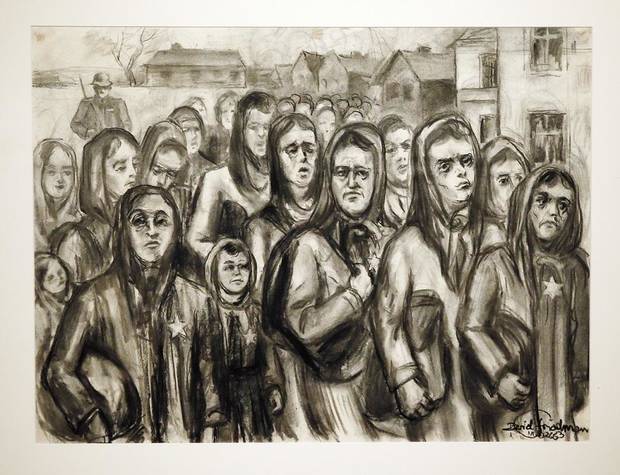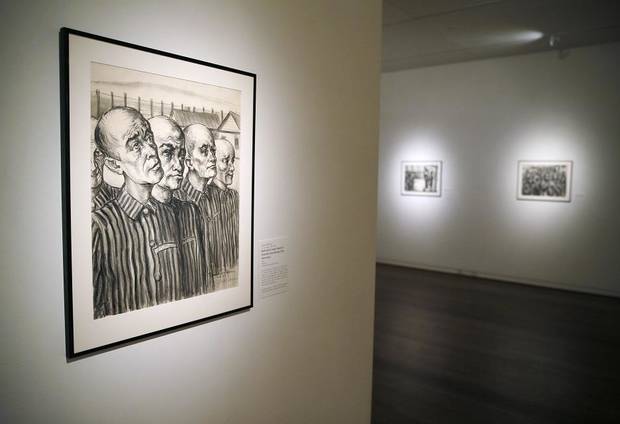News:
Interviews, photos and video: Artwork by Holocaust survivor David Friedman gives striking firsthand 'Testimony' at Fred Jones Jr. Museum of Art
By Brandy McDonnell
Artful 'Testimony': Fred Jones Jr. Museum of Art celebrating the work of Holocaust survivor David Friedman
More than 15 years after he was liberated from the infamous Auschwitz concentration camp at the end of World War II, Jewish artist David Friedman faced a new horror.
“My father was disturbed by the fact that people were forgetting the Holocaust,” recalled Miriam Friedman Morris, the late artist’s daughter. “He never forgot the paintings of the concentration camp and the ghetto. They remained buried in him, and as soon as he retired in 1962, they called. … And he went back to his work because he was disturbed by what he saw, even in America. He saw the KKK on television. This anti-Semitism that we see today was also happening for a long time. It hasn’t just started now.”
 "Women with Their Children on Their Way to an Unknown Concentration Camp" from the series "Because They Were Jews!" is on display in "Testimony: The Life and Work of David Friedman," an exhibit of work by the late Jewish artist, who was a Holocaust survivor, at the University of Oklahoma's Fred Jones Jr. Museum of Art in Norman, Okla.
"Women with Their Children on Their Way to an Unknown Concentration Camp" from the series "Because They Were Jews!" is on display in "Testimony: The Life and Work of David Friedman," an exhibit of work by the late Jewish artist, who was a Holocaust survivor, at the University of Oklahoma's Fred Jones Jr. Museum of Art in Norman, Okla.
 "Roll Call in Camp Gleiwitz, I" from the series "Because They Were Jews!" is on display in "Testimony: The Life and Work of David Friedman," an exhibit of work by the late Jewish artist, who was a Holocaust survivor, at the University of Oklahoma's Fred Jones Jr. Museum of Art in Norman, Okla
"Roll Call in Camp Gleiwitz, I" from the series "Because They Were Jews!" is on display in "Testimony: The Life and Work of David Friedman," an exhibit of work by the late Jewish artist, who was a Holocaust survivor, at the University of Oklahoma's Fred Jones Jr. Museum of Art in Norman, Okla
!["Women with Their Children on Their Way to an Unknown Concentration Camp" from the series "Because They Were Jews!" is on display in "Testimony: The Life and Work of David Friedman," an exhibit of work by the late Jewish artist, who was a Holocaust survivor, at the University of Oklahoma's Fred Jones Jr. Museum of Art in Norman, Okla. [Photo by Nate Billings/The Oklahoman]](https://cdn2.newsok.biz/cache/w620-91d08cecfc4173096e68efb215445b61.jpg) "Women with Their Children on Their Way to an Unknown Concentration Camp" from the series "Because They Were Jews!" is on display in "Testimony: The Life and Work of David Friedman," an exhibit of work by the late Jewish artist, who was a Holocaust survivor, at the University of Oklahoma's Fred Jones Jr. Museum of Art in Norman, Okla. [Photo by Nate Billings/The Oklahoman]
"Women with Their Children on Their Way to an Unknown Concentration Camp" from the series "Because They Were Jews!" is on display in "Testimony: The Life and Work of David Friedman," an exhibit of work by the late Jewish artist, who was a Holocaust survivor, at the University of Oklahoma's Fred Jones Jr. Museum of Art in Norman, Okla. [Photo by Nate Billings/The Oklahoman] !["Roll Call in Camp Gleiwitz, I" from the series "Because They Were Jews!" is on display in "Testimony: The Life and Work of David Friedman," an exhibit of work by the late Jewish artist, who was a Holocaust survivor, at the University of Oklahoma's Fred Jones Jr. Museum of Art in Norman, Okla. [Photo by Nate Billings/The Oklahoman]](https://cdn2.newsok.biz/cache/w620-6c39b8292d671f9f06db4148f39bc766.jpg) "Roll Call in Camp Gleiwitz, I" from the series "Because They Were Jews!" is on display in "Testimony: The Life and Work of David Friedman," an exhibit of work by the late Jewish artist, who was a Holocaust survivor, at the University of Oklahoma's Fred Jones Jr. Museum of Art in Norman, Okla. [Photo by Nate Billings/The Oklahoman]
"Roll Call in Camp Gleiwitz, I" from the series "Because They Were Jews!" is on display in "Testimony: The Life and Work of David Friedman," an exhibit of work by the late Jewish artist, who was a Holocaust survivor, at the University of Oklahoma's Fred Jones Jr. Museum of Art in Norman, Okla. [Photo by Nate Billings/The Oklahoman] !["A Few Seconds before Execution" from the series "Because They Were Jews!" is on display in "Testimony: The Life and Work of David Friedman," an exhibit of work by the late Jewish artist, who was a Holocaust survivor, at the University of Oklahoma's Fred Jones Jr. Museum of Art in Norman, Okla. [Photo by Nate Billings/The Oklahoman]](https://cdn2.newsok.biz/cache/w620-35f67714031471e1d937de1d55062f17.jpg) "A Few Seconds before Execution" from the series "Because They Were Jews!" is on display in "Testimony: The Life and Work of David Friedman," an exhibit of work by the late Jewish artist, who was a Holocaust survivor, at the University of Oklahoma's Fred Jones Jr. Museum of Art in Norman, Okla. [Photo by Nate Billings/The Oklahoman]
"A Few Seconds before Execution" from the series "Because They Were Jews!" is on display in "Testimony: The Life and Work of David Friedman," an exhibit of work by the late Jewish artist, who was a Holocaust survivor, at the University of Oklahoma's Fred Jones Jr. Museum of Art in Norman, Okla. [Photo by Nate Billings/The Oklahoman]
An abbreviated version of this story appears in the Sunday Life section of The Oklahoman.
Artful 'Testimony': Fred Jones Jr. Museum of Art celebrating the work of Holocaust survivor David Friedman
More than 15 years after he was liberated from the infamous Auschwitz concentration camp at the end of World War II, Jewish artist David Friedman faced a new horror.
“My father was disturbed by the fact that people were forgetting the Holocaust,” recalled Miriam Friedman Morris, the late artist’s daughter. “He never forgot the paintings of the concentration camp and the ghetto. They remained buried in him, and as soon as he retired in 1962, they called. … And he went back to his work because he was disturbed by what he saw, even in America. He saw the KKK on television. This anti-Semitism that we see today was also happening for a long time. It hasn’t just started now.”
On view through May 26 at the Fred Jones Jr. Museum of Art in Norman, the exhibit “Testimony: The Life and Work of David Friedman” is a survey of his artistic output. But the exhibit’s harrowing focal point is the series “Because They Were Jews!,” a visual diary of his time in the Lodz Ghetto in Poland and at the Nazi concentration camp of Auschwitz-Birkenau.
“It really does depict a firsthand account of his suffering: In the ghetto, it was largely starvation under a very kind of totalitarian system. In Auschwitz, obviously, it was a question of life and death every day. He never really knew if he would be selected arbitrarily to go to a gas chamber or whether he would be selected as part of a Nazi’s game. It was a really uncertain existence, and there’s a lot of tragedy to those images as he’s reflecting on that in the 1960s,” said Mark White, the Wylodean and Bill Saxon Director of the University of Oklahoma art museum.
“I think it’s important to remember what happened at Auschwitz. That was part of racial intolerance, economic intolerance. And it wasn’t just Jews; the Nazis selected a number of different groups that they found ‘undesirable’ to be interned. So, I think that those lessons of intolerance are useful reminders. … We are now 70 years away from the horrors of the German experiment, but it is, I think, useful to remember that.”
Tragic story
Friedman (sometimes spelled with two ns) was born in Mährisch Ostrau, Austria (now Ostrava, Czech Republic), but moved to Berlin in 1911, where he studied under German impressionist Lovis Corinth. With the rise of Nazism, he and his family escaped to Prague in 1938, where he continued to paint for himself and sold artwork until 1941, when the family was deported to Lodz Ghetto.
“He is not very well-known in part … because his career suffered under the persecution of the Nazis,” White said. “So much of his earlier work was either destroyed or looted by the Nazis. … Much of the work (in the exhibit) dates from the latter part of his career and is sort of a reflection on what had happened to him over the course of his life.”
In 1944, Friedman was separated from his wife and daughter, never seeing them again, and was transferred to Auschwitz-Birkenau. Friedman survived his internment at the notorious concentration camp and married fellow survivor Hildegard Taussig.
“It wasn’t easy. He returned to Prague after liberation, and the Stalinist Communists set themselves into Czechoslovakia. So, he fled again, didn’t want to live under tyranny, so he fled to Israel in 1948,” said their daughter, Miriam. “He persisted. He had to start over again in Israel at a time when it was in a poor economical situation, when there’s really not much room for artists except perhaps in commercial art, which is what he did. But soon his ambitions stretched to America.”The family emigrated to the United States in 1954, she said.
“My father, it was really quite amazing, at the age of 61, he started a new career without speaking English, hired on the spot for general outdoor advertising,” she said. “He found honor in this new career, painting billboards for the likes of Budweiser, so instead of painting Nazis, he was painting the Clydesdales. But he was happy to find this career at this age and being honored in this career by the company. We ended up in St. Louis, Missouri, where he became the head painter in that branch. So, it was quite an accomplishment in 15 months in America that they had given him that position.”
After he retired in the early 1960s, Friedman began converting his haunting Holocaust memories into artwork.
For more images of the artwork and an interview with the director of the museum, click on the link below.


